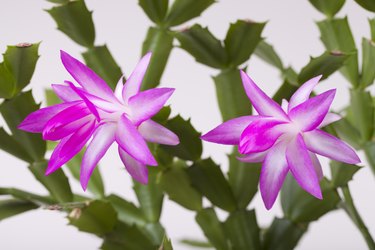
The red, peach, orange, cream or white flowers of a blooming Christmas cactus (Schlumbergera bridgesii) are a welcome sight during bleak winter months -- but not when they become infested with common household pests. They are reliable bloomers outdoors in U.S. Department of Agriculture hardiness zones 9 through 11 but can be grown indoors in all zones. Aphids and mealybugs are the most common pest problems for Christmas cactus, in addition to spider mites, fungus gnats and soft brown scale insects.
Signs of Mealybug Infestation
Video of the Day
Warning signs of mealybug infestation includes stunted or distorted growth. Mealybugs look like small dots of white cotton in the beginning stages of infestation. They are ⅛ to ¼ inch long and move very slowly. They develop visible legs as they grow bigger and the white, cottony area on the plant spreads. They appear first low on the leaf surface in the dark, warm, moist areas near the center stem of the cactus. Mealybugs feed on plant sap and leave a sticky honeydew substance as they spread. Mold is often a secondary problem from the honeydew residue.
Video of the Day
Aphids and Soft Brown Scale Symptoms
Aphids are often light green in color but may also be pink, brown, yellow or black. These pear-shaped insects are 1/16 to 1/8 inch long. Warning signs of an infestation on the Christmas cactus appear on new growth or the underside of leaves. Aphids also remove plant sap and cause distorted growth or yellowing leaves. New buds may appear misshapen. Aphids also deposit sticky honeydew residue on the plant -- mold can then grow and appear as dark splotches on the leaves. Soft brown scale insects also suck the sap from plant leaves, causing wilting and lack of vital growth. They appear as a waxy colored mass sticking to the stem or leaf underside. Both scale and aphids can be handpicked or scraped off the plant in the beginning stages of infestation.
Spider Mites and Fungus Gnats
Christmas cactuses grown indoors have more frequent problems with spider mites than plants grown outdoors. They are usually invisible to the eye until a light-colored, silken web is seen on leaves. The warning sign for these pests is light-colored speckling on the upper leaves and an overall faded appearance. Fungus gnats are weak fliers and are attracted to light as they feed on fungi that grow in potting soil. A gnat infestation causes a general unhealthy appearance or loss of leaves.
Methods of Control
Insecticidal soap is effective in controlling an outbreak of mealybugs, aphids or spider mites. The tiny pests may also be removed by blotting them with an alcohol-soaked cotton ball. A Christmas cactus plant with a heavy infestation of pests may need to be discarded. Aphids, soft brown scale and spider mites are sometimes dislodged with a forceful spray of water. Potting soil should be replaced when there is an infestation of fungus gnats because their larvae grow in the soil. Allow new soil to dry thoroughly between waterings and do not let standing water remain in the saucer. Chemical options may be used if preventative or natural methods fail to alleviate the problem. Insecticides containing pyrethrins, acetamiprid, imidacloprid, cyfluthrin or permethrin are used to control houseplant pests. Pyrethin-based commercial sprays can be applied every one to three days.
- Horticulture Magazine: Plants We Love: Christmas Cactus
- Clemson University Cooperative Extension: Common Houseplant Insects
- Clemson University Cooperative Extension Online: Thanksgiving & Christmas Cacti
- Texas A&M University: Insect Pests
- Grow Organic: Organic House Plant Care and Pest Control